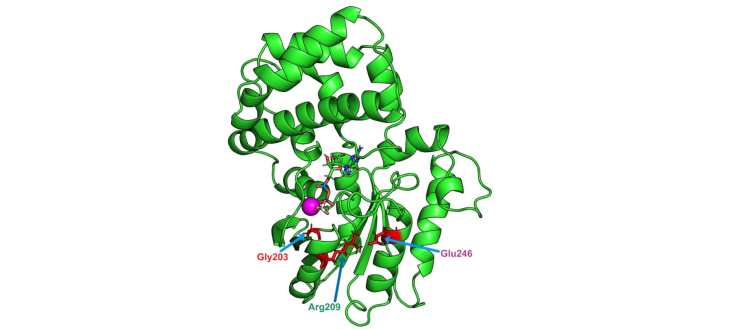A child with a rare genetic disease treated with zinc
The administration of zinc ions to a patient suffering from a severe neurodevelopmental disorder restored the function of a defective protein and significantly improved the child's quality of life.

Image: structure of the GNAO1 gene with the location of the three most frequent mutations.
Larasati et al., Sci. Adv. 8, eabn9350 (2022) 21 October 2022
A 3-year-old child suffering from a rare genetic paediatric encephalopathy has been treated by the oral administration of a simple zinc molecule, commonly used in other contexts. This medical breakthrough, reported on 16 August in an article in the journal Med, is the work of a team of scientists led by Vladimir Katanaev, whose research focuses precisely on this still experimental therapy. After eleven months of treatment, the young patient, suffering from a particularly severe form of the disease characterised by delayed intellectual and motor development, uncontrollable movements and epilepsy, and sometimes accompanied by cerebral lesions and atrophy, saw a significant improvement. And without side effects.
“Due to the disease, the child was suffering from very severe hyperkinetic seizures that were bringing him to the ER once a week," explains Vladimir Katanaev. “Hyperkinesia results in disorganised, uncontrolled movements that can damage the organs and even break bones. It is extremely dangerous, even fatal. As soon as we started administering zinc, our patient's condition improved."
In less than a year, the frequency of hyperkinetic seizures was reduced by a factor of 15 (from around twice a day to once a week), and epileptic seizures — which are fewer and less devastating but nonetheless added to the first — by a factor of 2.5. At the same time, his general motor skills improved dramatically. Perhaps the most poignant and subjective result is that his parents were able to reconnect emotionally with their child, who has finally smiled at them and is having better nights. In short, the child and his family have enjoyed a remarkably improved quality of life.
The neurodevelopmental disorder that affects this child is caused by a mutation in the GNAO1 gene. This gene codes for a protein, Gαo, which is one of the essential building blocks of neurons. This molecule normally follows a cycle of successive activation and deactivation, necessary for cell function. It is in particular responsible for transmitting signals from the outside to the inside of nerve cells.
A permanent activation
A mutation in the GNAO1 gene alters the Gαo protein by replacing a single amino acid with another. In previous work, the Geneva team showed that this simple defect means that the Gαo proteins are trapped in a state of permanent activation, with no possibility of deactivation, preventing them from performing their task and causing neurological disorders.
The mutation is heterozygous dominant, which means that one of the two copies of the gene is altered while the other remains functional. But this second allele is not sufficient: even if the neurons have one half of normal proteins, the neurodevelopmental effects are already devastating.
“It is a de novo, or spontaneous, mutation," explains Vladimir Katanaev. “This means that it occurs by mere chance without being present in the parents. This makes it a very rare disease. But it also makes it impossible to predict which baby will be affected.”
In an article published on 7 October 2022 in Science Advances, the Geneva-based scientists explain how they initially set out to identify a remedy to treat the symptoms of the disease. To do this, they developed a high-throughput screening system of thousands of already approved drugs, with the idea of identifying a molecule capable of restoring the activation and deactivation cycle of the Gαo protein.
This is how the team came across zinc pyrithione, an old antifungal and antibacterial drug used in cream form for certain skin diseases. Laboratory studies quickly confirmed that it corrects the loss of intracellular interactions. However, by taking the analysis a step further, Vladimir Katanaev and his colleagues noticed that it was the zinc ion alone that was effective. Luckily, this element is very easily found in any pharmacy and is already approved for the treatment of mild depression, insomnia and even, in some cases, developmental disorders in children. The same publication reports on tests carried out on a Drosophila fly genetically modified to mimic the disease. These showed that the addition of zinc to the insects' diet, from the larval stage and throughout their lives, resulted in an almost complete disappearance of the symptoms.
More than 150 mutations
“The child in our study carries a specific mutation in the GNAO1 gene," stresses Vladimir Katanaev. “Over 150 other mutations have been described in the scientific literature. In each case, the clinical manifestation of the genetic alteration may be different, resulting in more or less severe cases. We therefore began by classifying these mutations according to their response to treatment with zinc".
Laboratory work has made it possible to divide them into three groups. The first group includes mutations which, a priori, do not respond to zinc. The other two are those that do respond, but by two different molecular mechanisms.
Since July, Vladimir Katanaev's team has been taking part in a phase 1 clinical study at the University Hospital in Cologne, Germany, following a dozen patients aged between 6 months and 10 years, to whom the zinc treatment is administered. If the remedy is safe, scientists will be able to move on to the next phases. The idea is to identify the different clinical responses of this treatment, depending on the type of mutation they carry.
“Our aim is to halt the progression of the disease," hopes Vladimir Katanaev. “I don't think we will be able cure such neurological disorders, where the damage to the brain begins before birth and accumulates over time. But perhaps we will give these children a chance to make up some of their neurodevelopmental lost time.
30 Aug 2024